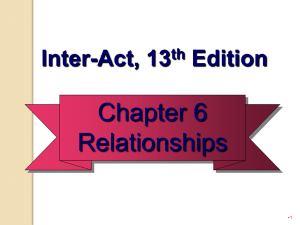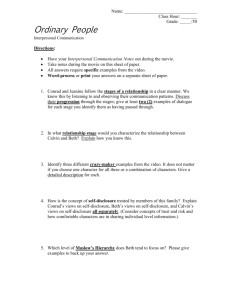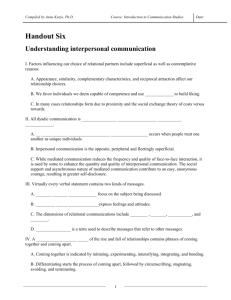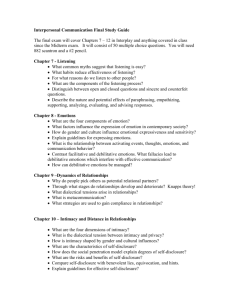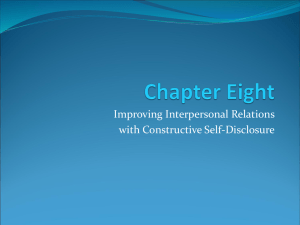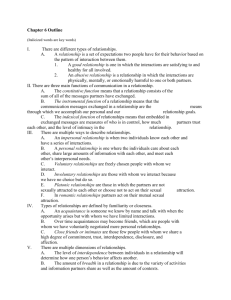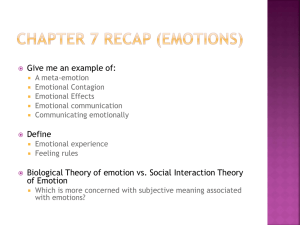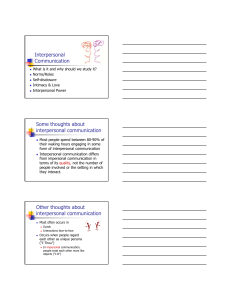diffused intimacy: trust and self-disclosure in online relationships
advertisement
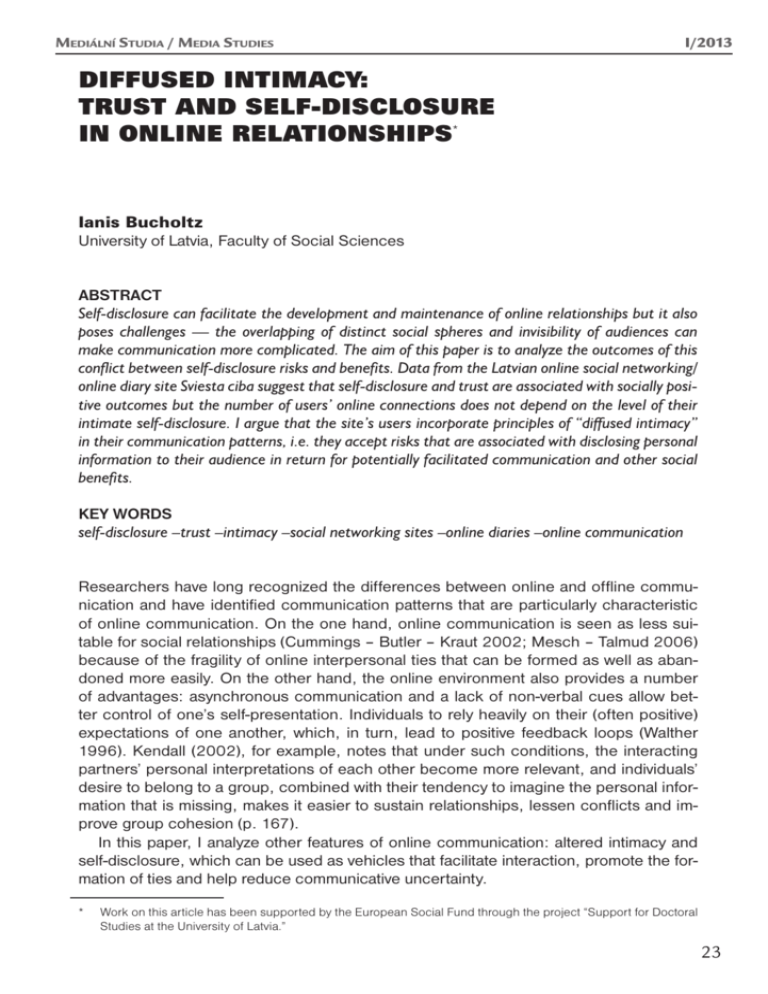
Mediální Studia / Media Studies I/2013 DIFFUSED INTIMACY: TRUST AND SELF-DISCLOSURE IN ONLINE RELATIONSHIPS* Ianis Bucholtz University of Latvia, Faculty of Social Sciences ABSTRACT Self-disclosure can facilitate the development and maintenance of online relationships but it also poses challenges — the overlapping of distinct social spheres and invisibility of audiences can make communication more complicated. The aim of this paper is to analyze the outcomes of this conflict between self-disclosure risks and benefits. Data from the Latvian online social networking/ online diary site Sviesta ciba suggest that self-disclosure and trust are associated with socially positive outcomes but the number of users’ online connections does not depend on the level of their intimate self-disclosure. I argue that the site’s users incorporate principles of “diffused intimacy” in their communication patterns, i.e. they accept risks that are associated with disclosing personal information to their audience in return for potentially facilitated communication and other social benefits. KEY WORDS self-disclosure –trust –intimacy –social networking sites –online diaries –online communication Researchers have long recognized the differences between online and offline communication and have identified communication patterns that are particularly characteristic of online communication. On the one hand, online communication is seen as less suitable for social relationships (Cummings – Butler – Kraut 2002; Mesch – Talmud 2006) because of the fragility of online interpersonal ties that can be formed as well as abandoned more easily. On the other hand, the online environment also provides a number of advantages: asynchronous communication and a lack of non-verbal cues allow better control of one’s self-presentation. Individuals to rely heavily on their (often positive) expectations of one another, which, in turn, lead to positive feedback loops (Walther 1996). Kendall (2002), for example, notes that under such conditions, the interacting partners’ personal interpretations of each other become more relevant, and individuals’ desire to belong to a group, combined with their tendency to imagine the personal information that is missing, makes it easier to sustain relationships, lessen conflicts and improve group cohesion (p. 167). In this paper, I analyze other features of online communication: altered intimacy and self-disclosure, which can be used as vehicles that facilitate interaction, promote the formation of ties and help reduce communicative uncertainty. * Work on this article has been supported by the European Social Fund through the project “Support for Doctoral Studies at the University of Latvia.” 23 Statě / Studies Ianis Bucholtz 1. Online Self-Disclosure Online communication is characterized by increased self-disclosure. Rheingold (1993) was among the first to point out that online interaction emboldens individuals to open up and reveal themselves “far more intimately than they would be inclined to do without the intermediation of screens and pseudonyms” (p. 13). The properties of online interaction — nonverbal cues, altered identifiability, asynchronous communication, and a need to reduce uncertainty — have an impact on individuals’ self-awareness, self-presentation considerations and other psychological aspects; in addition they also encourage self-disclosure and intimacy (Joinson 2004). It should be noted, though, that to some extent this applies to mediated communication in general, for example, in the case of conversations over the mobile phone held in public. At the same time, self-disclosure is also essential for the development and maintenance of both offline and online relationships. People tend to prefer those who disclose intimate details to those who disclose themselves to a lesser extent. Furthermore, people reveal more intimate information to those they like and also tend to like those to whom they have revealed intimate information (Collins – Miller 1994). This also applies to online communication. Gibbs et al. (2006) suggest that perceived success in online dating is predicted by self-disclosure. Ledbetter (2009) concludes that attitudes towards online self-disclosure are positively associated with uses of online interpersonal media and negatively with face-to-face communication. However, a more recent study on Facebook did not support this conclusion (Ledbetter et al. 2011). Mazer et al. (2007) argue that self-disclosure on Facebook can lead to better teacher-student relationships and classroom climate. Tidwell and Walther (2002) have noted that individuals in computer-mediated communication settings demonstrate more direct and intimate behaviour aimed at reducing uncertainty than do individuals in face-to-face settings. Park et al. (2011) suggest that the amount and positivity of self-disclosure on Facebook is associated with intimacy. Attrill and Jalil (2011) state that people who are more likely to reveal themselves online exhibit a more positive attitude towards online relationship making. These findings seem to confirm that self-disclosure in many cases facilitates online relationships. Thus, the potential for self-disclosure and intimacy can be viewed as one of the main reasons why formation of intense and emotional bonds in online settings is possible. Such a communication environment also creates new challenges as individuals must figure out how to make use of online interaction opportunities and at the same time cope with the possible consequences of these features. Online anonymity allows individuals to express themselves more freely without concerns about self-presentation. However, online identities can also be enduring, especially if they are based upon online social network profiles that display personal information and one’s history of activities. Lasting online identities and identities that connect offline and online environments can reduce the perception of freedom of expression and help solving a variety of online sociability problems. According to Matzat (2010), common sociability problems in online social groups are the lack of trust between participants, free-riding (participants’ contributions to group may not match the amount of resources what are being received) and changeability of group participants. Matzat argues that these problems can be addressed by adding offline contacts to online acquaintances. However, not all participants of online relationships want to extend their interactions to offline environments. One of the obstacles that might discourage online trust and self-disclosure is the invisibility of audiences. It is essential for an individual to see who is participating in a conversation 24 Mediální Studia / Media Studies I/2013 or following it because such information enables staging different “performances” for specific audiences (Goffman 1959). When a person communicates online, his or her ability to see the audience and get a sense of its reactions is limited. Moreover, social contexts collapse. Individuals’ online profiles can be found and followed by people who usually represent different segments of their network of acquaintances. Individuals try to present different messages to each of their audiences, but if such different groups become part of a single online social network, the individual at least partially loses his or her ability to show different “performances” to different audiences. Additionally, public and private realms blur as it becomes more difficult to maintain borders between them (Boyd 2011). To cope with the conflict between online self-disclosure and uncertainties resulting from the unclear borders between different social spheres, particular communication strategies must be adopted. Individuals can try to prevent their public and private lives from intersecting. This can be done, for example, using pseudonyms and hiding onlineonly identities when publishing private information. Online diaries, which are often used to publish private information (Moinian 2006), illustrate this approach. Writers of online diaries are encouraged by the anonymity that this format provides. De Laat (2008) characterized such self-disclosure as a “hard game to play”: despite the dangers, such as harassment and trolling, self-disclosure in many cases seems worthwhile because most visitors indeed act in a supportive and respectful manner. Another possible strategy to avoid the undesired consequences of self-disclosure is to rely on self-censorship and/or make use of different technical features that online interaction sites provide (e.g., Facebook groups or Google+ Circles). Individuals can develop higher awareness of the consequences of self-disclosure by controlling access to certain information and presenting different information to distinct groups. While such social and technical privacy controls might substantially reduce the friction between invisible audiences and disclosure, self-censorship can restrict the functionality and positive outcomes of online social networks. If an individual does not open up, he or she cannot expect self-disclosure from interaction partners. Therefore exchanging emotional, informational, and other resources and establishing mutual trust can be more difficult. In this paper, I propose a more sophisticated manifestation of self-disclosure management, an online relationship regime called “diffused intimacy”. The concept of “relationship regime” allows the distinction of interpersonal relationships not only by differentiating between online and offline relationships but also between different types of online relationships. A relationship regime encompasses relationships that are based on different principles, exist under distinct conditions, and differ in substance. According to the principles of diffused intimacy, an individual establishes personal relationships with other people in his or her online social network based on intimacy; individuals respond to online communicational uncertainties with trust and openness. Diffused intimacy is analyzed empirically in the online social networking site environment. 2. Diffused Intimacy In various online social networking environments, individuals establish, articulate and maintain ties with diverse kinds of contacts (Boyd – Ellison 2007). These online networks are used to gain access to informational, emotional, and other kinds of support. Other uses involve the formation and maintenance of relationships and self-expression. Academic research on online sociability suggests that social networks can facilitate personal connections between individuals — for example, use of Facebook is associated with 25 Statě / Studies Ianis Bucholtz higher levels of social capital (Ellison et al. 2011; Ellison et al. 2007). Valenzuela et al. (2009) report a positive relationship between students’ use of Facebook and life satisfaction, social trust, civic engagement, and political participation. Zywica and Danowski (2008) have found evidence that individuals who are popular and have higher self-esteem offline are also more popular on Facebook, while those who are less popular offline use Facebook as a means of social compensation. Individuals use these sites for effective online communication and are able to establish and maintain ties as well as exchange personal information. Observations on these sites demonstrate that users are able to cope with the uncertainties that are caused by the invisible audiences and blurring between distinct social spheres. The fact that individuals expose private information in their online social networks signalizes the emergence of new norms and an altered perception of self-disclosure. There is a need for research that explains the ways in which individuals cope with such situations. Diffused intimacy is established through a combination of trust towards others, selfdisclosure, and acceptance of the risks and uncertainties associated with adding users to one’s social network and sharing personal information with them. Under this relationship regime, intimate relationships are scattered across an individual’s online social network and the individual accepts that his or her private information transmitted over the network and associated with these intimate relationships is — at least partly — beyond his or her control. Other users’ trustworthiness cannot be inferred from previous interactions in the way it is usually achieved in offline interactions — new, often ad hoc, mechanisms of verifying trustworthiness must be employed. Individuals cannot count on predictability in such relationships; instead, they must find ways to deal with the risks and uncertainties that are an integral part of this altered intimacy. This “hard game to play” (de Laat 2008) becomes an essential part of successful online relationship making and other potential social benefits. In offline environments, individuals usually disclose themselves to a carefully selected group of trustworthy people. Interaction partners assume that the contents of their exchanges within such circles will be kept private and that the disclosed information will not be passed on to an unintended public. According to Sztompka (1999), the formation of trustworthiness is facilitated by closeness, intimacy, and familiarity. He states that the characteristics of Internet communication, such as anonymity, are limiting in terms of trust formation (Sztompka 1999: 81–82). However, as demonstrated by Henderson and Gilding (2004), participants in online interactions employ other sources of trust, some of which are reputations that individuals develop with their actions, uses of pseudonyms, and purposeful transformation of social contexts in which interactions take place — namely, by disclosing themselves, individuals encourage reciprocity. Observations on online self-disclosure and trust-building practices indicate the need to reconsider our understanding of online intimacy. In online environments, the circle of people who gain access to individuals’ intimate and personal information has widened. Individuals still carefully choose an audience for their online interactions but this selection is likely to be based on different and less rigid criteria. The amount of private information that individuals reveal about themselves may differ among social networking site users and trust between individuals remains something to be worked on in the relationships. However, intimacy remains the desired result of mutual interpersonal exchanges in online relationships. Reciprocal self-disclosure might increase intimacy between individuals who interact online (Park et al. 2011). Livingstone (2008) who has analyzed uses of social 26 Mediální Studia / Media Studies I/2013 networking sites among teenagers notes that individuals use these sites to exchange their private experiences, develop spaces for intimacy and connect with their friends. The diffused intimacy is consistent with the principles of individualization which states that in late modernity, personal relationships, social roles, and responsibilities are increasingly less determined by history, place, or tradition. Individuals are being liberated from predefined social categories such as gender, race, and status but this comes with personal responsibility for the construction of their own lives (Beck – Beck-Gernsheim 2002). This situation is characterized by growing uncertainty and disembeddedness (Bauman 2001). Under such conditions, trust and security are extremely valuable as a means of overcoming such disembeddedness. Individuals seek to engage in relationships that would help them build trust and achieve intimacy. For Giddens (1992), intimacy means a disclosure of emotions and actions that would otherwise be hidden from the eyes of the public (p. 138). Self-disclosure, which can be defined as revealing personal information to other people (Archer 1980: 183), is an essential element of intimacy (Laurenceau – Kleinman 2006; Gibbs et al. 2006). According to Giddens, intimacy has become compulsive in late modernity and many spheres of social relations require individuals to open up. An answer to contemporary demands for intimacy is what Giddens calls “pure relationships.” These relationships exist for the sake of interaction itself and the satisfaction they provide to individuals, and are centred on intimacy, equality, authenticity, and reciprocity. They are freed of external, pre-existing objectives and can be terminated if any of the participants wants it. Like other kinds of relationships, pure relationships depend on commitment, yet at the same time individuals who are engaging in such relationships must be prepared to see them end at any time (Giddens 1992). While empirical studies do not fully support concepts of individualization (de Beer 2007) and scholars have also criticised the discourse of pure relationships because the gap between cultural ideals and structural inequalities remains (Jamieson 1999), the notion of pure relationships provides a valuable perspective on online social interactions. Henderson and Gilding (2004), among others, have pointed out the usefulness of this concept in the research of this field. According to their observations, online self-disclosure and risk-taking promotes the formation of interpersonal connections that are consistent with characterizations of pure relationships (Henderson – Gilding 2004). There are more interactional uncertainties in networked online environments than in face-to-face settings, and initially there can be fewer shared social contexts that act as anchors and ease attempts at establishing and resuming interactions. Inequalities between individuals remain but might be transformed by the social enhancement and social compensation effects of the Internet (Zywica – Danowski 2008; Tufekci 2010; the former refers to the principle of “rich get richer” according to which those individuals who are already sociable, heighten their abilities to communicate with others even more. The latter, in turn, refers to observations that online communication provides a means of compensating for individuals who are less sociable in offline settings.) Under such conditions intimacy indeed becomes “compulsive” because there are few alternative strategies that can be effective in establishing personal and trustful connections. Under the diffused intimacy regime, users are at least partly willing to relinquish control over their personal information and take risks associated with such actions in order to facilitate online relationships with others. According to the theoretical assumptions outlined earlier, those users who are more open and have higher levels of trust in other users, are more engaged with others. In the next sections, I analyze quantitative and qualitative data 27 Statě / Studies Ianis Bucholtz to test these assumptions about diffused intimacy and assess the extent to which individuals engage in it in online private communication. 3. Method Qualitative data were collected using a web survey of users of the Latvian online diary and social networking site Sviesta ciba (N = 298). Established in 2002, it is one of the oldest social networking-based websites in Latvia and it has around two thousand active users. Sviesta ciba uses the engine of LiveJournal — an international blogging and social networking platform — therefore, the architecture of these two sites is similar. Each Sviesta ciba user has a nickname (real name use is uncommon) and creates a profile that contains some basic information about the user. Users can add other diary writers to their “friend list”, a section that aggregates entries from “friends”, i.e. individuals in whom the user is interested, usually because of the contents they post or personal connections among the users. When publishing an entry, the user can determine whether it will be public (accessible to everyone), semi-private (“friends-only”) or private (accessible to no one except the author). Since self-reported actions through the survey might differ from those in which users really engage, data gathered in the survey alone might not be sufficient to draw conclusions about users’ self-disclosure activities. Attrill and Jalil (2011) have observed that in initial interactions among individuals self-disclosure is associated with sharing superficial personal information — personal interactions increase quantitatively but not necessarily qualitatively. Thus, there is a need to analyze the contents and nature of online interactions among users in order to evaluate the conditions under which diffused intimacy is formed. Thus, the second stage of the research project involved the analysis of themes covered in Sviesta ciba users’ diary entries. The data were collected and thematically coded to identify the main themes; they were then divided into broad categories according to the levels of intimacy. With a custom-built crawler, I scanned the profiles of all users and generated a list of users according to their “popularity”. Popularity was determined by the number of incoming connections that each node of the Sviesta ciba social network has — in other words, the number of users who have added a particular individual to their “friends”. From the list of users, I selected a group of 18 popular participants (at least 150 users added them to their “friends list”) and 18 less popular participants (with fewer than 60 users adding them as “friends”). All of them allowed me to analyze their entries and also gave me access to their friends-only posts. Social networks are scale-free networks. It means that connections in the network are distributed unequally: a small number of nodes attracts most edges. In an online social networking site this means that a smaller group of users has many readers, “followers”, or “friends” while the majority of users have much fewer such connections. According to the principles of the distribution of connections in such a network, we can assume that the popular users are most fit (able to attract connections after accidental encounters) and most visible (e.g., most active) in the particular network (Barabási 2011). Thus, according to this rationale, the most popular users on Sviesta ciba are those who are more willing to share their personal information with others because, as noted earlier, self-disclosure facilitates online communication. By using data from Sviesta ciba, I will test these assumptions. It should be noted that online diary sites are generally more suitable for content analysis than “classic” social networking sites like Facebook. While typical social network 28 Mediální Studia / Media Studies I/2013 sites allow users to exchange private messages, virtual gifts, “pokes” at each other as well as “like” each other’s links and status updates, the main forms of interaction in online diary sites are text-based diary entries that are either public or semi-private (accessible to a limited group of people, but usually more than two). These interactions are easier for a researcher to follow and their contents easier to interpret because they tend to be more contextual than short status updates or non-verbal interactions such as “likes” and “pokes”. 4. Findings 4. 1. Online survey data analysis In the first step of the analysis, I use online survey data to evaluate trust and self-disclosure indicators and calculate the association between them and various uses of the social network/online diary site. The trust and self-disclosure measurement is based on a scale that was developed by Detenber et al. (2008) who used it in their attempts to analyze the impact of self-disclosure and perceived reciprocity on online friendships. Respondents were asked to respond to the following statements: “I feel I can trust my friends from this site”, “On this site, I can reveal intimate or personal information about myself”, and “On this site, I have written things about myself that my friends could not get from any other source”. Responses to these statements could be selected from among the following answers: “totally agree”, “somewhat agree,” “hard to say”, “somewhat disagree”, or “totally disagree”. To simplify calculating the means from scales with different lengths, answers were recoded with assigned values ranging from 0 to 1: 0 = disagree, 0.33 = somewhat disagree, 0.66 = somewhat agree, and 1 = totally agree. The answer “hard to say” was coded as a missing value. The mean scores for Sviesta ciba respondents were 0.58 (of 1) for trust in other users, 0.74 for users’ ability to write things about themselves that readers could not get from any other source, and 0.61 for publishing personal information. By using the SPSS function “Compute variable”, I added up the results from these three answers and created an index for self-disclosure and trust. This new variable will be used further to assess the relationship between self-disclosure/trust and social activities within online social networks. The index used a four-point scale in which 0 was the lowest and 3 the highest score. The self-disclosure/trust index for Sviesta ciba was 1.95. 4.1.1. Site uses and self-disclosure/trust According to research previously discussed in this paper, self-disclosure and trust facilitate the development and maintenance of online social interactions. To test this assumption, I ran a correlation analysis between the uses of Sviesta ciba and the self-disclosure/trust index (see Table 1). Survey respondents were asked to evaluate eight social activities in which they might engage on Sviesta ciba: “I collaborate to complete a task or make an idea come to life”, “I socialize”, “I provide advice or information”, “I receive advice or information”, “I provide emotional support”, “I receive emotional support”, “I provide material (e.g., financial) support”, “I receive material (e.g. financial) support”. Again, these answers were recoded to fit in the interval from 0 to 1, where 0 = never, 0.33 = seldom, 0.66 = sometimes, and 1 = often. The answer “hard to say” was coded as a missing value. Since my data did not comply with the parameters of a normal distribution, I used Spearman’s correlation coefficient rs for calculations. 29 Statě / Studies Ianis Bucholtz Table 1. Correlation matrix of social network site usage with self-disclosure and trust index Social activities Self-disclosure and trust index I collaborate to complete a task or make an idea come to life .206* I socialize .162* I provide advice or information .127 I receive advice or information .166* I provide emotional support .311** I receive emotional support .308** I provide material support .057 I receive material support .120 Note: * p < 0.05; ** p < 0.01 The analysis showed a statistically significant relationship (p < 0.05) between self-disclosure/trust and a number of the aforementioned uses of Sviesta ciba, except exchange of material support. Among the uses measured, providing emotional support and receiving emotional support have the strongest correlation; users with high scores in self-disclosure and trust are more likely to engage in emotional exchanges with other individuals online. The absence of association between self-disclosure/trust and exchange of material support suggests that such interactions are perceived as less sensitive. 4.1.2. Online sociability and self-disclosure/trust. In the next step, I ran a correlation analysis between the self-disclosure/trust index and a number of variables that indicated users’ online and offline sociability. Respondents were asked to evaluate the extent to which these statements applied to their use of Sviesta ciba: “I’ve got many friends”, “I like to have company”, and “I communicate with other users of this site a lot”. They could choose from among the following answers: “totally agree”, “somewhat agree”, “hard to say”, “somewhat disagree”, and “disagree”. (As before, the answer “hard to say” was marked as a missing value.) The first two statements refer to offline sociability but the last one denoted online sociability. Respondents were also asked to specify how many comments or messages from other users they received during the past seven days, how many online diary posts they publish per week, and how much time per day they spend on Sviesta ciba. Answers to these six statements and questions were correlated with the self-disclosure/trust index. 30 Mediální Studia / Media Studies I/2013 The results show that a statistically significant relationship exists between self-disclosure/trust and online sociability (rs = 0.284, p < 0.01), however, there is no association with statements that refer to offline sociability. Also, there is a relationship between the number of feedback units received (rs = 0.229, p < 0.01) and the number of diary posts published (rs = 0.32, p < 0.01). It means that those users who have higher levels of self-disclose and trust are more likely to engage in interactions with other users on Sviesta ciba; the members of this group report that they also publish entries more often and receive more feedback. 4.2. Self-Disclosure in Online Diaries At this point, quantitative data seem to support the notion that self-disclosure and trust are associated with facilitated online communication and those individuals who are more capable of opening up are most likely to engage in intimate interactions (i.e. exchange emotional support). To test this assumption further, I analyzed online diary entries to determine the levels of self-disclosure and the amount of private details that users post online. Based on the number of incoming connections that participants in the Sviesta ciba have, I selected 36 users — 18 popular (well-connected) and 18 less popular — and included 30 consecutive diary entries from each of them in the sample, for a total of 1080 analyzed entries. Themes covered in the online diary entries were merged into five broad categories varying in the degree of intimate self-disclosure: (1) public issues (posts on societal, political and economic topics), (2) socializing (general private interactions about family life and household, private activities, hobbies and interests, everyday observations and experiences), (3) work (professional duties, experiences, problems, and challenges), (4) phatic communication (entries whose purpose was to keep the user connected with others without transmitting messages that are meaningful outside the context of a particular conversation, such as small-talk), and (5) intimate issues (personal topics such as romantic relationships, health issues, sex, problems, failures, and emotions). Such categorization of the entries makes it easier to characterize the prevalence of intimate information on Sviesta ciba. 4.2.1. The most discussed topics Table 2 shows the differences between the popular and the less popular group. It can be observed that the arrangement of topics by frequency of use is rather similar in both groups. The most popular general topic in both groups is socializing-related. Every user whose online diary was included in the study published at least one diary entry that contained themes related to socializing. Themes of socializing makes up 56 % (the popular group) and 60 % (the less popular group) of the coded items. The next most widely used category was intimate issues. In both groups, 17 users had at least one entry that matched this category, and the number of times such codes were used is relatively similar in both groups. These themes make up 16 % of the popular and 18 % of the less popular group’s items. This was followed by public issues. More users from the popular than the less popular group discussed such issues, although the less popular users talked about these more intensively (11 %) than the popular users (8 %). The fourth category was phatic communication. The number of users engaging in small talk was equal but the popular group relied on such communication patterns more often than the less popular group: 12 % and 5 %, respectively. Work-related issues were least discussed. This topic was slightly more frequently discussed by the popular group (8 %) than the less popular group (7 %). 31 Statě / Studies Ianis Bucholtz Table 2. Comparison between the popular and the less popular users by themes in their online diary entries Themes The popular users The less popular users Public issues 17 (81) 14 (108) Socializing 18 (548) 18 (597) Work 14 (78) 13 (71) Phatic communication 17 (116) 17 (50) Intimate issues 17 (156) 17 (181) Total 83 (979) 79 (1007) Note: The first figure denotes the number of users (in each group of 18) who published at least one entry on a given topic. The second figure (in parentheses) shows how often this topic was mentioned in the entries by the users in a given group. Most of the popular and the less popular group members mainly use their online diaries for private self-expression and exchanges with other users. While there are some significant differences between these two groups, such as the intensity of phatic communication, intimate disclosures, and public issues, the general trends are relatively similar. The data suggest that the number of connections in the network might not depend on the themes that a user covers in his or her diary. While the number of connections can be linked to a person’s individual writing skills and offline acquaintance with users rather than the content of entries, when it comes to general topics that are being discussed, the number of Sviesta ciba user connections does not seem to be linked to self-disclosure. 4.2.2. Intimacy-Related Topics Altogether, almost 17 % of all items that were coded are about intimate issues (337 of 1986 in total), with relatively small differences between the popular and the less popular users — as shown in the previous section, the difference is only two percentage points (16 % for the popular group and 18 % for the less popular group). The similar results suggest that the prevalence of this type of communication is not determined by an individual’s online “popularity” or success in establishing connections. In the next step, I evaluate entries about intimate issues in more detail (see Table 3). For the popular group, the four most common intimate self-disclosure topics were emotions, thoughts about oneself and one’s life, health, and hardships and failures. The same topics were most widely discussed also by the less popular group. The only difference is the order: the less popular group deals with topics of hardships and failures and thoughts about oneself and one’s life more frequently than the other group while the popular group talks about emotions considerably more often than the less popular group. 32 Mediální Studia / Media Studies I/2013 Table 3. Intimacy and self-disclosure-related themes The popular users The less popular users Number of users writing about it Number of times mentioned Number of users writing about it Number of times mentioned Emotions 13 49 13 28 Thoughts about oneself and one’s life 10 25 15 36 Health 10 24 9 20 Hardships and failures 8 18 11 40 Memories 8 13 7 8 Relationships (including romantic) 7 12 6 19 Self-analysis 4 7 5 10 Dreams (in sleep) 3 4 7 8 Sex, sexual relationships 2 2 2 11 Physiological details 2 2 1 1 Total 156 181 To determine whether the difference in self-disclosure between the popular and the less popular users can indeed be considered small, I ran a final analysis to see if there was a difference between male and female users regarding the themes discussed. Among the 18 male users whose entries were analyzed, 16 published at least one entry among the 119 total entries (13 %) in the intimate issues category. 17 of the 18 female users published at least one entry of the 218 times intimate issues were coded. Of all items that were coded in men’s diary entries, 13 % (119 of 897) were intimacy-related. In contrast, of all items that were coded in women’s diary entries, 20 % (218 of 1089) were intimacy-related. The data show that not only fewer male users were writing about intimate issues but female users were discussing such topics much more frequently. The main limitation of this analysis is the small sample of Sviesta ciba users. Further research should test these results by using larger samples and including other social networking/online diary sites. 33 Statě / Studies Ianis Bucholtz 5. Discussion In this paper, I have empirically tested the diffused intimacy relationship regime that explains networked online self-disclosure. According to its principles, individuals are willing to give up partial control over their private information in exchange for effective interaction enabled by self-disclosure and trust in others. Online self-disclosure facilitates communication and eases the development of social ties thus it can help engaging in social exchanges and support with other members of the network. But at the same time it can be risky to reveal private details about oneself. The findings of this research demonstrate that individuals who are more capable of selfdisclosure and trust are also more successful in establishing and maintaining online connections. Quantitative data indicate those individuals who open up also engage in social interactions more often, especially receiving and providing emotional support. A viable strategy for developing mutually positive relationships required for such support would be self-disclosure which encourages reciprocity (Collins – Miller 1994). Diffused intimacy implies that private information is being communicated via an online social network even though the individual does not know exactly who his or her audience is and if all audience members are trustworthy. Taking such risks seems to pay off because data show that individuals who are more open also engage in closer relationships that are based on the principles of pure relationships (Giddens, 1992). Importantly, online self-disclosure and trust is not associated with self-reported offline sociability, thus my data seem to contradict earlier studies that have found a link between online self-disclosure and avoidance of offline social contacts (Ledbetter 2009; Caplan 2005). The ability to gain access to online social resources is related to a more complex set of variables than solely an individual’s offline sociability characterizations or social skills. One can assume that those who are able to engage in intimacy-based relationships should have a larger number of connections in the social network. However, the analysis of online diary entries did not support this assumption. Instead, the results show that intimate self-disclosure is characteristic of a significant portion of online social network users regardless of their popularity and visibility on the network. In my sample of online diary entries, around 17 % of the items were related to intimate self-disclosure. The difference in self-disclosure rates was small between the popular and the less popular users — about two percent (16 % and 18 %, respectively). The only difference is that the less popular group tended to discuss more “introvert” topics such as hardships and failures and thoughts about oneself and one’s life while the popular group places slightly greater emphasis on “extrovert” topics such as discussing emotions. In comparison, the difference between the intensity of male and female users of intimacy-related topics was seven percent (13 % and 20 %, respectively) and women talked about intimate issues considerably more often than men. Therefore gender was a more feasible determinant of self-disclosure than the number of online connections an individual had. The seeming contradiction between the findings based on qualitative and quantitative data can be explained by the diverse uses of the social networking/online diary site and diverse communication approaches. Not all users strive to become popular. In fact, many choose to keep a low profile and a smaller audience because such a strategy allows them to expand their freedom of expression with fewer risks of undesirable consequences. Limiting the invisible audience is one of the possible ways in which individuals simultaneously try to embrace the online environment and to manage the uncertainties that are associated with disclosing private information. 34 Mediální Studia / Media Studies I/2013 To keep their online social networks functional for self-expression and networking, individuals have to adapt new modes of conduct that let them combine these conflicting activities essential for online communication and tie-building. Uses of such networks for personal self-expression, or access to emotional, informational, and other kinds of resources for developing and maintaining social ties require privacy and intimacy trade-offs that distinguish these kinds of social interactions from their offline counterparts. 6. Conclusion Private interactions in online environment are characterized by heightened self-disclosure (Rheingold 1993; Joinson 2004). Previous research has demonstrated that online selfdisclosure is positively associated with a number of socially positive outcomes (Mazer et al. 2007; Tidwell – Walther 2002; Park et al. 2011) and the findings of this study support this. It has also been suggested that intimacy issues matter most to individuals who have low levels of trust, while privacy concerns are most relevant to those who use communication technologies less frequently (Frye – Dornisch 2010). Thus, online social networks can be seen as an environment in which individuals can develop new customs of opening up and trusting others as well as re-examining and questioning perceptions of the level of privacy that is needed for personal comfort and safety. The analysis of online interpersonal interactions demonstrate that intimacy no longer means self-disclosure to an exclusive and relatively narrow group of familiar individuals. The altered understanding of intimacy does not require familiarity as a precondition of selfdisclosure. A number of other safety measures can be used to develop a sense that it is fine for an individual to disclose private details about himself or herself. Individuals might try to restrict access to their network from outside, choose pseudonyms, hide personal details, and self-censor personal information that is being published. But none of these strategies can give them the sense of being in full control over what happens to the information that is disclosed. This is one of the reasons why individuals are encouraged to develop an opposite approach towards communicating private details online. In parallel with managing their privacy, individuals also develop ways to cope with the inevitable uncertainties that are associated with the disclosure of private information. It seems that taking privacy-related risks to communicate more intimately and effectively with others is becoming the norm. For a segment of contemporary participants in online communicative spaces, developing and maintaining an effective online social network is more attractive and useful than controlling their private information. In online settings, the conflict between self-disclosure benefits and risks is significantly reduced. It is largely attributed to the relative anonymity and an individual’s ability to take control over the information he or she shares (Ben-Ze’ev 2003). Diffused intimacy refers to a more complex characterization of processes that make online intimacy possible. It is a relationship regime and as such it refers to a set of conditions and practices through which individuals disclose themselves in order to establish and maintain connections with others, engage in emotional exchanges, and fulfill other social needs. Although diffused intimacy is formed in online social spaces, anonymity itself is not necessarily a core condition for it. Many participants in online communities also know each other and interact in offline settings. While initial encounters between participants in online social spaces are often framed by anonymity which encourages and facilitates (and, of course, also restricts) certain actions, in time these contacts — whether or not they extend to an offline environment — usually become much less anonymous. However, 35 Statě / Studies Ianis Bucholtz once anonymity is reduced, individuals in the online social group are unlikely to turn more secretive because of that — they still strive to maintain intimacy in their relationships. An understanding of online intimacy should not solely be reduced to a phenomenon that is enabled by a specific type of communication medium and exists as long as the initial characterizations of communication through such media remain intact. Since we are dealing with communication practices that are to some extent being converted from anonymous online relationships to non-anonymous online relationships to non-anonymous offline relationships, I argue that the conceptualization of these processes should be more human-oriented, rather than medium- or technology-oriented. The present account is by no means the first attempt to characterize the changes in the disclosure of personal information online. Schwarz (2011) has described the shift in social practices of interpersonal communication that can be observed in the ways teenagers use communication tools. Since a growing part of interpersonal interactions takes place in written form, the content of such conversations is accessible later for unintended modes of consumption, e. g. it is possible to copy a quote by a previous conversation partner and paste it in a different context for the entertainment of others; such archives of previous conversations are also used as evidence of what a certain person has said. Schwartz states that “formerly separate events coalesce and take place simultaneously, with information leaking from one to the other’ and participants of such conversations have been aware that the audience of their conversations can be larger than just the intended receiver of their messages (Schwarz 2011). In the present article I interpreted the changing modes of self-disclosure and intimacy differently. Although I argue that the personal information that is being published online and distributed via an online social network goes beyond the control of its author, I also imply that there are norms that prevent readers from abusing such self-disclosure. The existence of such norms cannot be taken for granted and the online social network user cannot always be aware of his or her full audience; they cannot prevent misuse of personal information. However, such a disclosure of intimate information is possible at least in part because users of the particular online social space perceive and accept such norms and other users act according to their interpretations and perceptions of these. The formation and perception of norms regarding online privacy is a direction of research that requires further exploration for a more nuanced understanding of online self-disclosure and of the establishment and manifestations of diffused intimacy in online interpersonal relationships. Ianis Bucholtz (Jānis Buholcs) received his PhD from the University of Latvia in 2013. His research interests include social networks, interpersonal communication, and online media. He teaches courses in new media economics and online journalism and also writes for Latvian media on foreign affairs and Internet-related issues. E-mail: janis.buholcs@lu.lv 36 Mediální Studia / Media Studies I/2013 References: Archer, Richard L. 1980. „Self-disclosure.“ Pp. 183–204 in The self in Social Psychology. Eds. Wegner, Daniel M. – Vallacher, Robin R. London: Oxford University Press. Attrill, Alison – Jalil, Rahul. 2011. „Revealing only the superficial me: Exploring categorical self-disclosure online.“ Pp. 1634–1642 in Computers in Human Behavior, 27 (5). Barabási, Albert-László. 2011. „Introduction and keynote to A Networked Self.“ Pp. 1–14 in A Networked Self: Identity, Community, and Culture on Social Network Sites. Ed. Papacharissi, Z. New York: Routledge. Bauman, Zygmunt. 2001. The Individualized Society. Cambridge: Polity Press. Beck, Ulrich – Beck-Gernsheim, Elisabeth. 2002. Individualization: Institutionalized Individualism and its Social and Political Consequences. London: Sage Publications. Ben-Ze’ev, Aaron. 2003. „Privacy, emotional closeness, and openness in cyberspace.“ Pp. 451–467 in Computers in Human Behavior, 19 (4). Boyd, Danah. 2011. „Social network sites as networked publics: Affordances, dynamics, and implications.“ Pp. 39–58 in A Networked Self: Identity, Community, and Culture on Social Network Sites. Ed. Papacharissi, Z. New York: Routledge. Boyd, Danah – Ellison, Nicole. 2007. „Social network sites: Definition, history, and scholarship.“ Pp. 210–230 in Journal of Computer-Mediated Communication, 13 (1). Caplan, Scott. 2005. „A social skill account of problematic internet use.“ Pp. 721–736 in Journal of Communication, 55 (4). Collins, Nancy L. – Miller, Lynn Carol. 1994. „Self-disclosure and liking: A meta-analytic review.“ Pp. 457–475 in Psychological Bulletin, 116 (3). Cummings, Jonathon N. – Butler, Brian – Kraut, Robert. 2002. „The quality of online social relationships.“ Pp. 103–108 in Communications of the ACM, 45 (7). de Beer, Paul. 2007. „How individualized are the Dutch?“ Pp. 389–413 in Current Sociology, 55 (3). de Laat, Paul B. 2008. „Online diaries: Reflections on trust, privacy, and exhibitionism.“ Pp. 57–69 in Ethics and Information Technology, 10. Detenber, Benjamin H. – Wijaya, Mindawati – Goh, Hui Yi. 2008. „Blogging and online friendships: The role of self-disclosure and perceived reciprocity.“ Paper accepted for presentation to the Communication and Technology Division of the International Communication Association at the 58th Annual Conference to be held in Montreal, Canada, 22-26 May 2008. http://citation.allacademic.com/meta/p_mla_apa_research_citation/2/3/2/5/5/p232554_index.html (1. 4. 2012). Ellison, Nicole B. – Lampe, Cliff – Steinfeld, Charles – Vitak, Jessica. 2011. „With a little help from my friends: How social network sites affect social capital processes.“ Pp. 124–145 in A Networked Self: Identity, Community, and Culture on Social Network Sites. Ed. Papacharissi, Z. New York: Routledge. Ellison, Nicole B – Steinfeld, Charles – Lampe, Cliff. 2007. „The benefits of Facebook ‘friends’: Social capital and college students’ use of online social network sites.“ Pp. 1143–1168 in Journal of Computer-Mediated Communication, 12 (4). Frye, Nancy E. – Dornisch, Michele M. 2010. „When is trust not enough? The role of perceived privacy of communication tools in comfort with self-disclosure.“ Pp. 1120–1127 in Computers in Human Behavior, 26 (5). Gibbs, Jennifer L. – Nicole B. – Heino, Rebecca D. 2006. „Self-presentation in online personals: The role of anticipated future interaction, self-disclosure, and perceived success in Internet dating.“ Pp. 1–26 in Communication Research, 33 (2). Giddens, Anthony. 1992. The Transformation of Intimacy: Sexuality, Love and Eroticism in Modern Societies. Cambridge: Polity. 37 Statě / Studies Ianis Bucholtz Goffman, Erving. 1959. The Presentation of Self in Everyday Life. New York: Doubleday. Jamieson, Lynn. 1999. „Intimacy transformed? A critical look at the ‘pure relationship’.“ Pp. 477–494 in Sociology, 3. Henderson, Samantha – Gilding, Michael. 2004. „‘I’ve never clicked this much with anyone in my life’: Trust and hyperpersonal communication in online friendships.“ Pp. 487–506 in New Media & Society, 6 (4). Joinson, Adam. N. 2004. „Self-esteem, interpersonal risk, and preference for e-mail to face-to-face communication.“ Pp. 472–478 in Cyber Psychology & Behavior, 7 (4). Kendall, Lori. 2002. Hanging Out in the Virtual Pub: Masculinities and Relationships Online. Berkeley: University of California Press. Laurenceau, Jean-Phillipe – Kleinman, Brighid M. 2006. „Intimacy in personal relationships.“ Pp. 637–653 in The Cambridge Handbook of Personal Relationships. Eds. Vangelisti, Anita L. – Perlman, Daniel. New York: Cambridge University Press. Ledbetter, Andrew M. 2009. „Measuring online communication attitude: Instrument development and validation.“ Pp. 463–486 in Communication Monographs, 76 (4). Ledbetter, Andrew M. – Mazer, Joseph P. – DeGroot, Jocelyn M. – Meyer, Kevin R. – Mao, Yuping – Swafford, Brian. 2011. „Attitudes toward online social connection and self-disclosure as predictors of Facebook communication and relational closeness.“ Pp. 27–53 in Communication Research, 38 (1). Livingstone, Sonia. 2008. „Taking risky opportunities in youthful content creation: Teenagers’ use of social networking sites for intimacy, privacy and self-expression.“ Pp. 393–411 in New Media & Society, 10 (3). Matzat, Uwe. 2010. „Reducing problems of sociability in online communities: Integrating online communication with offline interaction.“ Pp. 1170–1193. American Behavioral Scientist, 53 (8). Mazer, Joseph P. – Murphy, Richard E. – Simonds, Cheri J. 2007. „I’ll see you on ’Facebook’: The effects of computer-mediated teacher self-disclosure on student motivation, affective learning, and classroom climate.“ Pp. 1–17 in Communication Education, 56 (1). Mesch, Gustavo – Talmud, Ilan 2006. „The quality of online and offline relationships: The role of multiplexity and duration of social relationships.“ Pp. 137–148 in The Information Society, 22. Moinian, Farzaneh. 2006. „The construction of identity on the internet: Oops! I’ve left my diary open to the whole world!“ Pp. 49–68 in Childhood, 13 (1). Park, Namkee – Jin, Borae – Jin, Seung-A A. 2011. „Effects of self-disclosure on relational intimacy in Facebook.“ Pp. 1974–1983 in Computers in Human Behavior, 27 (5) Rheingold, Howard. 1993. The Virtual Community: Homesteading on the Electronic Frontier. Reading: Addison-Wesley. Schwarz, Ori. 2011. „Who moved my conversation? Instant messaging, intertextuality and new regimes of intimacy and truth.“ Pp. 71–87 in Media, Culture & Society, 33 (1). Sztompka, Piotr. 1999. Trust: A Sociological Theory. Cambridge: Cambridge University Press. Tidwell, Lisa Collins – Walther, Joseph B. 2002. „Computer-mediated communication effects on disclosure, impressions, and interpersonal evaluations: Getting to know one another a bit at a time.“ Pp. 317–348 in Human Communication Research, 28. Tufekci, Zeynep. 2010. „Who acquires friends through social media and why? ‘Rich get richer‘ versus ‘Seek and ye shall find’.“ Pp. 170–177 in Proceedings of the fourth international AAAI conference on weblogs and social media (ICWSM 2010) Menlo Park, CA: AAAI Press. https://www. aaai.org/ocs/index.php/ICWSM/ICWSM10/paper/view/1525 (3. 3. 2013.) Valenzuela, Sebastián – Park, Namsu – Kee, Kerk F. 2009. „Is there social capital in a social network site?: Facebook use and college students’ life satisfaction, trust, and participation.“ Pp. 875–901 in Journal of Computer-Mediated Communication, 14 (4). 38 Mediální Studia / Media Studies I/2013 Zywica, Jolene, Danowski James. 2008. „The faces of Facebookers: Investigating social enhancement and social compensation hypotheses; predicting Facebook and offline popularity from sociability and self-esteem, and mapping the meanings of popularity with semantic networks.“ Pp. 1–34 in Journal of Computer-Mediated Communication, 14 (1). 39
